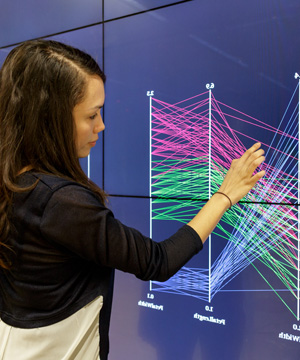
The programme comprises 120 ECTS, with the following compulsory elective, compulsory, elective and research components:
- Four modules covering the areas of 'HCI Fundamentals' and 'HCI Technologies': Psychology, HCI Concepts and Methods, Visual Interfaces and Computer Vision; each module with 6 ECTS; within each module students can choose one from 2 courses on offer for the module.
- A specialisation module where students choose one further course from 'HCI concepts and methods' and 'HCI technologies' areas.
- A Design Theory course, focusing on design theory and digital culture, run at the Faculty of Arts + Design.
- Two research projects, comprising 30 ECTS in total (12 ECTS + 18 ECTS).
- Electives module (24 ECTS in total).
- The Master’s thesis module (30 ECTS).
In accordance with the Weimar model, research projects make up a large proportion of our master’s programme. The electives module allows students to incorporate a large variety of courses from other degree programmes and faculties alongside the general Computer Science for Digital Media course catalogue.
The fourth and final semester is dedicated to preparation of the master’s thesis, the topic of which may be selected from the suggested topics of the various professorships. Following successful defence of the master’s thesis, a Master of Science degree is awarded.
The standard duration of the Human-Computer Interaction M.Sc. degree programme is four semesters. Students can begin this programme in either the winter or the summer semester.
A Wide Range of Electives
The electives module allows for the inclusion of a range of courses from other programs, such as Media Studies, Media Management, Architecture and Urbanism, Media Art and Design, Product Design, Visual Communication, and others. An additional HCI-related project may also be incorporated.
Courses from Computer Science for Digital Media that have not already been calculated into the master’s programme may also be included. Furthermore, graded language courses worth a maximum of 7 credit points may be brought into the Electives module.
The Electives module (along with projects and theses) enables students to create their personal profile and specialisation. Some of our students have done a 3d project in Product Design, while others have decided to deepen their technological expertise in Computer Science courses. Many students take part in various Media Arts and Design or Arts/Design courses (Fachmodule) that mix creative work with lab-based practical skill acquisition. For German-speaking students there is also the option to attend courses in neighbouring Jena or Erfurt Universities (on request).
